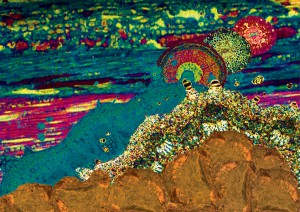 I created this microscape in 2007, using images that I gathered from a trinocular microscope examining stained plant tissue specimens that I then digitally manipulated.
I created this microscape in 2007, using images that I gathered from a trinocular microscope examining stained plant tissue specimens that I then digitally manipulated.
I would not have known that photomicrography was a field of artistic practice amongst scientists, had I not stumbled upon the images posted by photomicrographers.
The OSS facilitates collaboration, but unless users venture out of their comfort (content transmission) zones that merely document their (solo) developmental trajectories, their processes of visual representation and expression will perpetuate the creator-viewer dualism. Contrariwise, the participatory universe that Ascott (1984, 1990) envisions in the semantic sea, entails “dispersed authorship”, participation, and recontextualization, uncertainty, uneasiness, and disequilibrium, fuzziness and ambiguity.
The exploratory, reflexive and dialogic processes of telematic art are however met with the performative pressures to succeed in the high stakes examination system that terrorizes students through the accountability or audit regime. Collaboration, which is invisible in audit terms, is thus ignored, as the “terrors of performativity” (Ball, 2003) displaces the soul, whose quest is to vanquish all academic rival to emerge with that elusive A or distinction, at NTU, where student are often graded on the normalized bell curve.
My concern is, that OSS users whose professional soul is being possessed by the terroristic dominance of performativity, will never know, what they don’t know. How would they know whether their creative decisions are the wisest, from the range of options?
Ang (2010) contends that the competitive high-stakes audit regime in Singapore retards designerly cognition, which requires a millieu of collaboration that supports what Chua (2009) terms technologies of foolishness or experimentation. The process rather than product emphasis is the focus.
In Diana Toh’s performance, the process of tearing into the the black canvas on the wall, was far more eviscerating and visually arresting than the final product, that consisted of splattered marks. I wonder how the GCE A level examiners (who patently value the final artwork or product, over the preparatory sketches or process) will take to marking a splattered wall? I ask this, because in the 2008 examiners’ report, the examiners commended candidates who continued to experiment with their work even during the final execution of the painting, even though as supervisors, we knew that it was euphemism for students who had failed to thoroughly document their research process.
This obsession over the final product over the process at the, primary, O and A levels, may continue to haunt ADM undergraduates. The ghost of the schooling (as opposed to the education) system, may still haunt OSS users, who see little benefit in collaborating or challenging each other’s thinking.
Had I not been challenged to find a new way to represent plants in 2007, I would have never discovered the exciting field of photomicrography. I wouldn’t have known, what I didn’t know.
References
Ang, W. W. K. (2010). Art education within a competitive paradigm : challenges & alternatives from a Singapore perspective. Saarbrücken: VDM Verlag Dr Müller.
Ascott, R. (1984). Art and telematics: Towards a network consciousness. In H. Grundmann (Ed.), Art Telecommnications (pp. 25-67). Vancouver: Western Front.
Ascott, R. (1990). Is there love in the telematic embrace? Art Journal, 49(3), 241.
Ball, S. J. (2003). The teacher’s soul and the terrors of performativity. Journal of Education Policy, 18(2), 215-228. doi: 10.1080/0268093022000043065
Chua, S. M. J. (2009). Saving the teacher’s soul: exorcising the terrors of performativity. London Review of Education, 7(2), 159-167. doi: 10.1080/14748460902990344